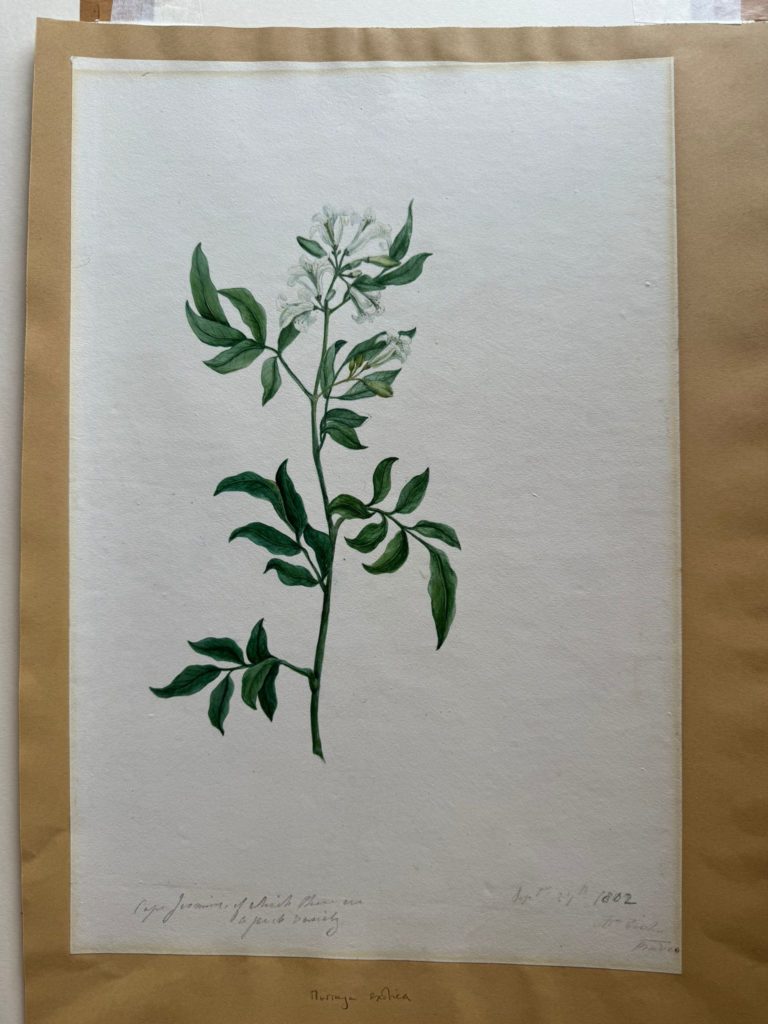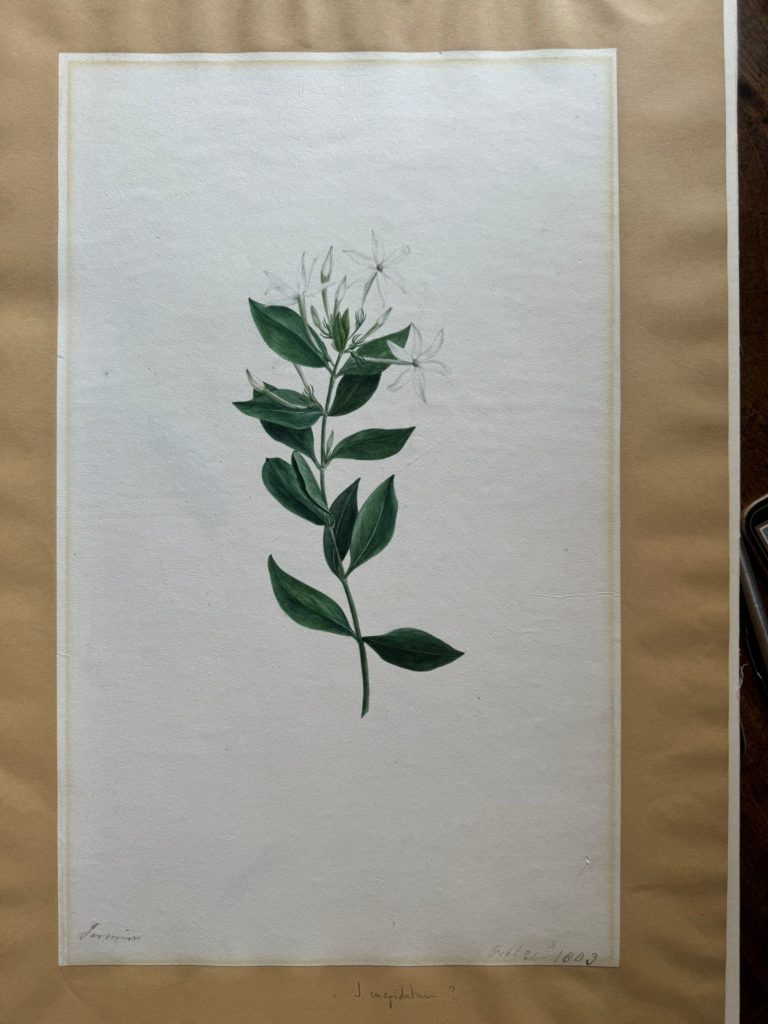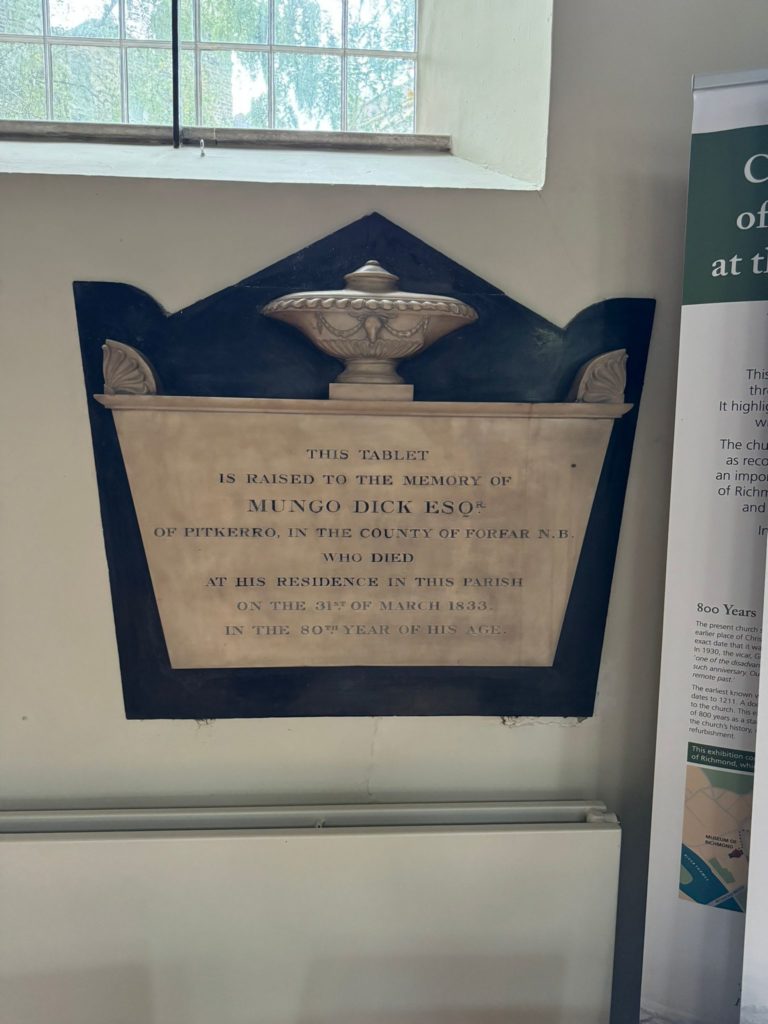I recently acquired two botanical watercolours by Janet Dick (1774–1857) painted in Madras in 1802 and 1803. Competent enough in execution, the main reason for buying them was that they were made at exactly the same time that Elizabeth, Lady Gwillim and her sister Mary Symonds were also drawing natural history subjects in Madras. In an earlier ‘Botanics Story’ I discussed Elizabeth’s drawing of a Magnolia (https://stories.rbge.org.uk/archives/34065). I contacted Victoria Dickenson in Montreal, the instigator of the highly successful Gwillim Project (https://thegwillimproject.com/), and was delighted to find that the Symonds sisters had indeed crossed paths with Janet Dick. Mary made two delightfully catty references to her in letters to her London-based sister Hester James.
On 11 February 1802 Mary wrote:
But the grand lady of all is a Mrs. Dick her husband is the highest member of counsil [sic] who is married, in consequence of which she takes place of every body in the settlement just as the Lady Mayoress does in the City I believe he is very rich, she is rather pretty and at least 20 years younger than he is; her father is a Taylor at Charing Cross his name is Douglas she has a brother here a writer. Living with Mrs. Dick is a Miss Boydell a niece of the Aldermans [i.e. John Boydell the engraver and publisher] she is about fifty years old she came out here about a year or two ago with Mrs. D.- she dances away at the balls and attends all the publick amusements of the place, some people say she is a good sort of woman and only came here at the particular request of Mrs. D with whom she had been very intimate for some time, but others are of opinion that she intends to captivate.
And on 14 October 1804:
an honest man is the noblest work of God, but if you want instances I will give two or three from the heads of our society. The first lady here after the Governors wife & Betsy [Lady Gwillim], is the daughter of a Douglas the taylor who lived near Charing Cross. Two others who hold their heads next are daughters of a Mrs Goldfinch a Hosier in Lombard Street, here are five sisters all well married in the eye of the world at least, daughters of an inferior custom house officer who lives on Tower hill. Two more great ladies are the daughters of an Innkeeper at Hounslow, two more daughters of a slop shop at Portsmouth.
This inspired me to undertake some internet genealogy to discover more about Janet and her family (the usual strong caveats must be born in mind). Here is the story so far.

Janet was born in 1774, daughter of Robert Douglas (1741–1804) and Sarah Davis (b 1748). Her father certainly did have some sort of textile business at Charing Cross but, unknown to the snobbish Symonds sisters, he also happened to be of Scottish gentry stock rather grander than their own. Robert Douglas was the 15th of the Douglas Lairds of Mains, Dumbartonshire, at a time when it was not unknown for Scottish gentry to go into ‘trade’. He must have been prosperous and in addition to the Charing Cross property had a country villa, Weston House, Chertsey in Surrey. Janet had at least three brothers John, Archibald and Colin, and the inheritance of Mains went through John (d 1815), then Colin (1781–1820). The family had Indian connections: her cousin Henrietta Campbell married Archibald Swinton, Lord Clive’s ADC (see https://stories.rbge.org.uk/archives/34047 for another connection); and, as noted by Mary Symonds, Janet’s brother Robert became a Madras writer (he arrived there in 1802 and died at Tuticorin in 1814).
Mary Symonds’s reference to Janet’s companion Miss Boydell as a niece of Alderman John Boydell is of great interest. Boydell is best known for his ambitious artistic Shakespeare project – the commissioning of paintings illustrating the plays from artists such as Romney, Fuseli, Benjamin West and Angelica Kauffman, which were displayed in the Shakespeare Gallery and engraved for a nine-volume, folio edition. There were clearly family connections between the Douglases and Boydells as Janet’s younger brother Colin Douglas was married to a Sophia Armine Boydell, perhaps a sister of the Madras Miss Boydell. Might this lie behind Janet’s own artistic interests, about which the Symonds sisters would surely have been interested had they taken the trouble to find out?

In 1798 at St Martin’s in the Fields in Trafalgar Square Janet married the 45-year-old EIC Madras civil servant Mungo Dick (1753–1833). On the disparity of ages Mary Symonds was more or less correct – in fact Janet was 21 years younger than her husband. Mungo was another member of the Scottish gentry as laird of Pitkerro, a handsome 16th/17th century mansion just north of Broughty Ferry embellished for Lt Col A.C. Douglas-Dick by Robert Lorimer in 1902–4. As a child I birdwatched in its wooded policies and learned to distinguish the song of a blackcap from that of a garden warbler.
Mungo’s family also seem to have been involved in textiles, or rather its materials, as his father John had a profitable thread-making business in Dundee. In 1770 Mungo went as a writer to Madras and, according to evidence that he gave to a Commons Select Committee in 1813, spent four years in Madras, then 20 in the Northern Circars, first as assistant in the Commercial Department then as Commercial Resident. Doubtless enriched, he returned to Britain and married Janet, but in 1799 he returned with her to India, where he stayed for a further ten years in a senior position as a Member of the Madras Board of Trade. Although an old label states that Janet’s paintings were made in Madras between 1792 and 1807 at least the first date is wrong, though it is possible that she did leave two years before her husband for the sake of her children.
Of these children at least three were born in Madras. The first two were recorded in the Asiatic Annual Register as sons, but in fact the first, born in May 1800 appears to have been a daughter, Georgina Janet (who would marry the Hon Pownoll Bastard Pellew and died in Devonshire in 1870). The second, born December 1802, would seem to have died young as there is no further trace of him. In July 1807 came John Campbell Dick who later joined the EIC and died in Calcutta in 1845. After Mungo’s and Janet’s return to Britain Robert Kerr Dick was born at Pitkerro and baptised in Dundee in August 1810; he too became a Bengal Civil Servant and died in France in 1881. The couple, and their descendants retained links with, and probably also spent time, at Pitkerro as in 1818 Mungo was listed as a subscriber to the Dundee Infirmary. However, it was in ‘his house on Richmond-hill’ that he died on 31 March 1833. On a recent visit to Kew I visited the parish church of St Mary Magdalene in Richmond to see his monument. Janet survived her husband by 24 years and died in London in 1857.
It is not known how many drawings Janet made in Madras and only four are presently known. These were mounted on a heavy buff paper and originally bound in an album that at some point must have been dispersed. In the Yale British Art Center, New Haven, Connecticut is a drawing of Toona ciliata, which was purchased by Paul Mellon in 1984 from William Drummond of Bury Street, London. Charlie Mackinnon an antique dealer in St James’s, London, currently has a watercolour of Senna cf. surattensis that was also previously sold by Drummond. My two drawings were purchased from Abbott and Holder in 2021.
I am grateful to Victoria Dickenson of McGill University, and to Brooke Krancer and Laurel Peterson of the Yale Center for British Art for helpful discussions.
Henry Noltie

